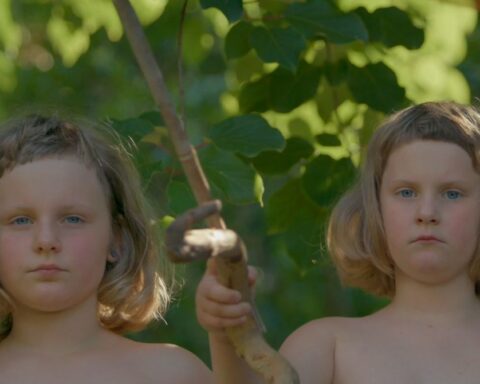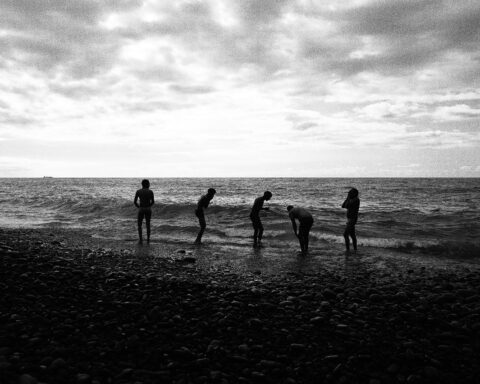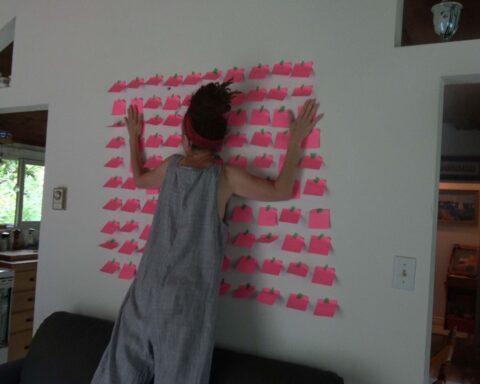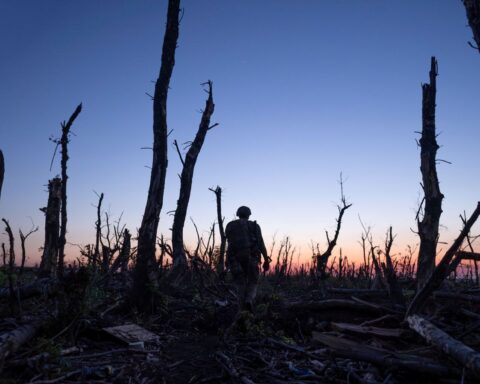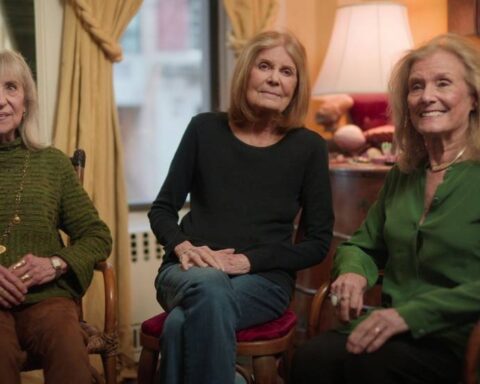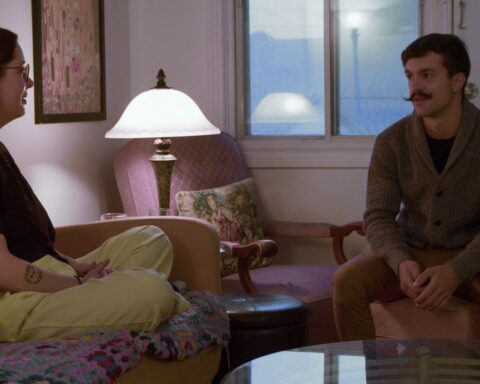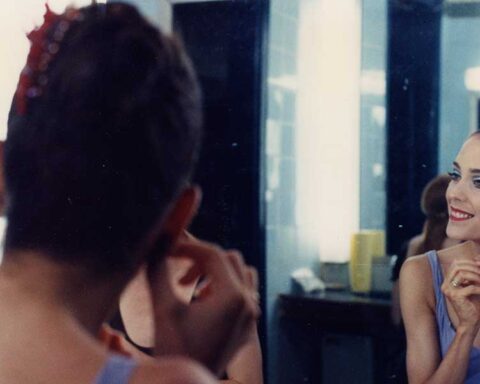“In my dreams I harvest my realities into film dreams.” Phil Hoffman never said those words to me, but here’s why I dreamt he could have.
Hoffman Harvests a Film Culture
Late June in Ontario is synonymous with the harvest of luscious field strawberries. Eager city folks flock to rural ‘pick-your-own’ outlets such as Andrew’s Berry Farm in the Mennonite-rich community of Mount Forest to avail themselves of the delicious crop. Meanwhile, at a modest 35-acre farm up the road, a different kind of harvest gets underway. A dozen handpicked ‘farmers’ arrive at Phil Hoffman’s self-made film lab-in-a-barn, for an intense week long immersion in filmmaking. Fondly referred to as the ‘film farm’, it attracts urban dwellers who travel to the country to sample Bolex cameras, film chemicals and 16mm celluloid, while munching pints of Andrew’s berries.
An award winning filmmaker and highly regarded professor, Hoffman purchased his rural property in 1992 and started the workshop two years later with Marian McMahon, who has since passed away. He carries on, as survivors do, with a new partner Janine Marchessault and her daughter Jessi lending their support. With each passing year, the self-effacing, immensely talented Hoffman refines what the hand-processing workshop can offer. It started as a seed idea that sprouted by word-of-mouth, and has harvested more than one hundred auteurs toiling in self-styled, handmade filmmaking.
The tenth year of the workshop took place last summer and I was one of twelve participants invited to attend. It was a healthy mix of eight ‘girls’ and four ‘boys,’ some emerging and some established filmmakers, with a few returning for a second retreat. I arrived from Wilberforce, Ontario to join participants from Finland, San Francisco, Buffalo, Halifax and Toronto. Everyone was eager to play with raw stock, experiment with concepts and collaborate in a cloistered community of like-minded ‘regular life’ escapees. Independent filmmaking covers four decades for me and for an old friend, renowned experimentalist Barbara Sternberg. Her presence encouraged me to experiment with form, and for each of us, hanging out in a film environment like this forced us to make our Bolex cameras an extension of ourselves, and to investigate the immediate environment, searching for moments to express on film.
Within a mere day or two of arrival, the ‘film farm’ became the ‘filmed farm.’ Nature, in some form, surfaced in the personal searches that took place on the rolls of 16mm celluloid that caught light while fluttering past the camera lens.
I began my seven days on the farm at sunrise, setting out to find early morning magic to transport through the mechanism of the camera. The farm allowed a form of freedom I rarely find in daily life, with creative time as expansive as the landscape. Total immersion makes dreaming cinematic impossibilities into reality the norm. Everything I shot was handheld, frame-by-frame, as I traversed the countryside for key locations. In the darkroom I flash-solarized some of my footage and then applied tint and tone chemicals for colour magic.
Being at the farm is draining and revitalizing in equal doses, a working vacation for confirmed film-oholics. The setting of the workshop is integral to what happens over the course of the week, as fields and barns, rivers and dirt roads, horses, cows, dogs and goats figure predominantly in most films. Hoffman’s barn acts as a catalyst not only for hand processing, tinting and toning, but also for intimate experimentation with subject matter that would not normally surface if the work shop was held in downtown Toronto. More than a hundred filmmakers have shot this landscape, in endless ways, and with individualistic results, and many more will no doubt discover their own unique interpretation in years to come.
Over the week each participant shot five spools (500 feet) of high contrast B&W optical film stock, generally working 12 to14-hour days. Hoffman keeps a B&W processing machine in the basement of his stone house to process film in a pinch, but the goal is for participants to hand-process it themselves in the darkrooms, which is a challenge at first, but yields magic when you stick with it.
After the film is hand developed, it’s colour treated, roughly edited and then shown in Hoffman’s rustic, well-equipped barn ‘screening room,’ complete with sunlight filtering through wood slats and wild birds flying around. Goats inhabit the barn basement and devour anything not nailed down, including plastic bags, electric cords and filmstrips. Participants not wanting the ‘chewed’ look watch for their filmstrips hanging on clothes lines that sometimes get carried off by sudden high winds.
It’s impossible to keep wood splinters and barn-dust off the endless streams of film hanging to dry on string placed throughout the barn. Being at the farm is not about keeping film in pristine condition. Experimentation with altering ‘clean’ emulsion is desirable. After I assessed the dirt that had landed on my rushes, I found myself degrading the emulsion even further by wire brushing, scratching, stoning and purposefully dragging film along the barn floor. You can have fun while reaping amazing results.
The main barn holds four Steenbeck machines, four rewind stations with Moviescopes, two dark rooms for hand processing movie film, a projection booth and a screening room adequate for twenty people. The amount of equipment is remarkable, especially given that Hoffman houses livestock in the barn basement. Existing in this natural atmosphere, and feeling the built-in support system, reinforced my theoretical appreciation and practical approaches for the artistic medium I most cherish— film.
Working with film stock is synonymous with a hands-on experience. It contrasts starkly with the technological distancing of digital film that is rapidly becoming the norm. You put your fingerprints on film when it’s handled, and DNA spills on sections —that old ‘sweat and blood.’
Film studies programs are rapidly switching to digital production, by necessity, but some are even sacrificing entirely their older analogue equipment. Sadly the emerging film school generation risks missing out on the ‘film’ part of filmmaking. The process of making films on celluloid is different than digital, and finishing on film yields different results (although the gap is closing).
Phil Hoffman has found dedicated helpers to lead participants through workshops in hand processing techniques, colour tinting & toning, bleaching, painting and other emulsion shifting treatments. His goal is to foster artistic expression, in an unhindered environment, devoid of high cost technology. He helps harvest a fresh crop of self-styled, mainly experimental and mostly personal films every year that are unveiled at an informal barn screening before participants return to their regular-life existences.
Past farm attendees crop up everywhere. Many are active filmmakers who have used hand-processing techniques in their subsequent work. Larissa Fan graduated from the Integrated Media Program at the Ontario College of Art and Design (OCAD) in 1994, with a stunning short documentary, Ten Little Dumplings. She was at the farm two years ago and has since undertaken her Masters in the Department of Film and Video at York University.
“I found the farm was a great place to recharge. The handmade techniques that are taught there made me realize that filmmaking could be a part of everyday life, like sketching or writing, and not necessarily an onerous task. In The Garden is a short experimental film that came directly from the farm experience. I shot it in my garden, processed in my basement and dried it on the lawn. It’s a completely ‘home-grown’ film.”
Christina Zeidler is another stellar OCAD grad who went to the farm several years ago and subsequently made an exquisite experimental short film Traces (2002). It’s a heartfelt remembrance of her dog—and it blew me away.
Hoffman hosted an outdoor party for more than a hundred past participants and friends last summer to mark the tenth anniversary of the image retreat. He projected farm films on a gigantic outdoor screen mounted on the barn, and complemented the evening with live music and a catered dinner.
How did a man with a Bolex camera, a stone farmhouse and a desire to mentor emerging talent come to change the film culture of Mount Forest—and Canada?
Hoffman Harvests a Learning and Teaching Environment
The film farm is not my first encounter with Hoffman. We go back almost 30 years, to a fond time at Sheridan College, studying Media Arts, where he made a short family portrait entitled On the Pond (1978). Hoffman taught film at Sheridan for 17 years before moving to the Department of Film & Video at York University six years ago. After 23 years of teaching Hoffman still sees learning and teaching as cyclical: filmmaking feeds his classroom, teaching feeds his films, and both fuel his success.
His teaching has influenced three decades of film students, including the likes of Mike Hoolboom and Steve Sanguedolce. He’s inspired many others at the film farm. Hoffman’s importance as a professor and film farm guru can’t be disassociated from his work as a solo artist: deeply pensive, Bolex in hand, undertaking visceral examinations of his life. His cinematic pattern of blending personal life with public spheres began unfolding at Sheridan in the mid 1970s, under the direction of a highly influential film teacher Rick Hancox, who had a profound and lasting effect on many of us.
It’s 1975. I’m hanging out in a large, open area called the common room at Sheridan College, (now a rabbit warren of small classrooms), which, back then, was the prime spot for creative exchange and student collaboration. Alan Zweig, Holly Dale, Lorraine Segato, Richard Kerr, Phil Hoffman and myself have a hip, young film teacher who starts up a 16mm film course, and we’re his trial students.
Lorraine shoots footage of my hair which she later rotoscopes. Alan arranges an interview for his film on taxi drivers. Holly and I agree to crew Lorraine’s film about a sexual encounter between two women, and afterwards we edit our student film on transvestites, transsexuals, homosexuals and drag queens.
That’s how it was in those days. Sheridan’s Media Arts program was a hub of activity, led by experimental filmmaker and extraordinary professor Rick Hancox, who is presently teaching at Concordia University. Hancox affected a generation of students to become film artists, musicians and university professors. Jeff Paull’s experimental film class also had a lasting effect on Phil, who was quiet at school. Not surprisingly, Hoffman formed a close friendship with another quiet guy in the program, Richard Kerr.
Hoffman and Kerr followed in Hancox’s wake, developing first as extraordinary experimental filmmakers, and later becoming influential film professors. The core group of students I hung out with at Sheridan College three decades ago have forged active careers. We have intersected at creative moments over the years, including Kerr’s questioning of Hoffman for an essay published in Landscape with Shipwreck (2002).
*What is your favorite journey? Inner. It’s cheap, fast, and out of control.*
Introspective by nature, it was natural for Hoffman to explore his own inner landscape when Hancox advised his students to ‘film what they knew best.’ He has followed his own path, drawing on remnants of his life to fashion a special brand of fiction and nonfiction hybrid film, based partially on autobiographical recall.
What is your favorite journey? Inner. It’s cheap, fast, and out of control.
I am a young boy on a frozen pond,
pushing a puck that the dog tries to get.
I am a woman in oversized earmuffs,
playing to the camera on a snow-covered field.
I am a mother Swan floating on a river in Helsinki, protecting my young.
These are characters in Hoffman films. And it is striking to witness how often his characters look through the lens, in search of the filmmaker. It’s a technique based on Hoffman’s process of finding himself through the making of his own works. He documents events in front of his lens to uncover documentation more deeply understood taking place behind the camera. Hoffman extracts chosen bits of information about himself, and with precision, blends his findings on screen, in characters and occurrences, by wrapping his personal narratives seamlessly into the folds of more universal stories. This practice has earned him an international, award-winning reputation as a leader of the diaristic genre.
On the Pond (1978) is a classic Hoffman title, and yet, since it’s a student film, he named it long before he could have guessed it would become one of his signature pieces. To be ‘on’ the pond indicates that it’s frozen, as so much of the memory he draws on is ‘frozen’ in a state of his own recall. And it further suggests two recurring themes in Hoffman’s work; one is the implied danger of ‘thin ice’ and the other is the ‘transformation’ of water turning to ice. Metaphorically, the thin ice Hoffman plays with is his inner landscape, and the danger is in revealing it, while the transformation is the journey of self-discovery he opens himself to with each film he undertakes.
We watch the filmmaker as a young boy, moving the puck around a frozen pond in solitude, intercut with his family exuberantly reminiscing about ‘frozen’ moments in photographs of their past. It’s deceptively simple, as if anyone could have made it, but already the stamp is purely Hoffman—a calm surface hiding riptides than can carry you away. The family dynamic is on the surface: nothing is overstated, it’s all unavoidably clear and yet rather hazy, as Hoffman reveals a family seemingly filled with good cheer, but whose awkward happiness is a cover for life’s disappointments.
The role of Hoffman as a young boy in On the Pond is acted, but in the final scene the real-life filmmaker joins his cinematic character on the ice. It’s part home movie and part cinematic fiction, which are the blurred lines Hoffman tends to tread, blending fiction with nonfiction, the actual with the imagined, the personal and more generic.
What these ashes wanted (2001) is Hoffman’s seventeenth film, and it conveys most overtly his emotional ambitions when undertaking a personal journey on celluloid. Hoffman bares himself in this memory portrait that pays homage to his late partner Marian McMahon, and he unabashedly expresses his anguish in her sudden passing. I suspect that ‘ashes’ in the title belongs not only to McMahon who is gone, but also to the state of being Hoffman feels in being left behind. The film is neither Hoffman’s release of McMahon, nor hers of him. It is clearly Hoffman’s release of himself, a release from the ashes to emerge as a changed being.
What these ashes wanted is a disquietingly haunting film that immediately draws you into the intimacy of a private relationship, and later cuts to the universal heart of losing anyone who is dear. It is a brave film, and a necessary meditation on a topic that still scares many people to even watch, let alone live with for years while creating work.
Whereas On the Pond and What these ashes wanted have received opulent mentions, a Hoffman film that doesn’t receive as much attention is Chimera (1996). In Greek mythology, the Chimera is made of several parts: a lion’s head, goat’s body and serpent’s tail; but in a broader sense, and more relevant to the film, chimera is an illusion or fabrication of the mind, especially in an unrealizable dream.
The film appears at first to be on the surface, mainly about technique. The camera is always moving, rhythmic music forms a steady beat, and it could be a study of film as hypnotic tool. But _Chimera_ is Hoffman’s most understated film that explores his two most common themes: death and chaos. And it is perhaps his most immediate film dealing with frozen moments, life transitions and fragments of memory.
The shots are in constant movement and it makes the image blurred a good portion of the time; periodically, a readable moment will appear, just briefly, and then the movement continues. It’s a statement in chaos at its most heightened state. The world is blurry with only snatches of clarity—it’s moving fast with only glimpses of calm. You never know exactly where you are or what is going on, except for fleeting moments.
Hoffman is working with stills, as he frequently does, but this time they come not as photographs, but in briefly readable motion picture pauses of clarity. You only get to study the ‘still’ for an instant before it’s gone. It’s absolute motion madness, and still picture insanity. Adding to the feelings of chaos, some of the film is shot in foreign places and there’s a montage of foreign voices, adding to the feeling that being in the world is a foreign experience for those who never know where to land, or where they belong.
Hoffman often expresses a fascination, and a dread, of death in his films, and he captures both feelings in the synergy of Chimera. Even though it was made five years earlier, Chimera serves as a companion film to the breadth of emotion, depth of grief and heightened alienation one feels in response to What these ashes wanted.
Hoffman harvests lasting results
A veteran filmmaker, Hoffman is also celebrated for his teaching, and for running the film farm. He has followed the path of Hancox, and carved out his own place as a filmmaker and teacher, influencing a generation set to follow in his path.
The harvest of Hoffman includes a solid collection of experimental diaristic films, the numerous students he’s affected at Sheridan and York, and his film farm alumni who help keep Kodak happy in the digital era. Hoffman’s cultivation continues in the next generation of filmmakers, who are harvesting their own crop of distinctive handmade cinema.
Of Hoffman’s many efforts, the film farm is most unique. It’s a low-tech, hands-on event that remains focused on the development of individual artists and the production of personal film works. And it provides filmmakers at any stage in their career a place to regenerate.
Coda: The Next Harvest
Hoffman decided not to offer the workshop in 2005 so that he could hold a retreat with his staff, to define the next chapter of what the film farm can offer. He is also searching for funds to help offset the cost of running, and taking the film farm. But there’s no doubt the farm will be ready to harvest a new crop of ‘film farmers’ in the summer of 2006.




